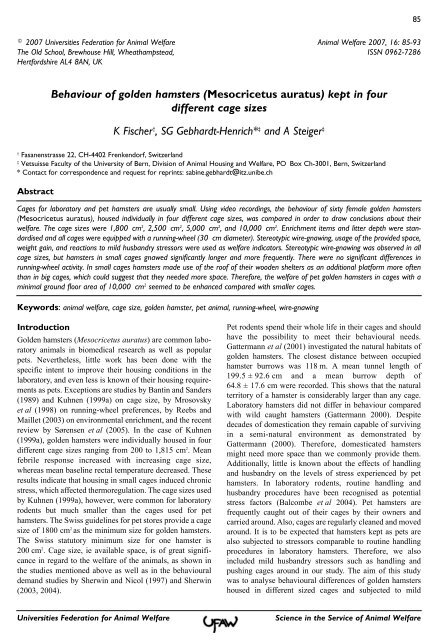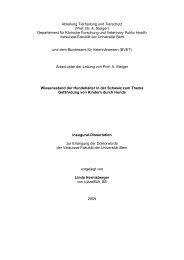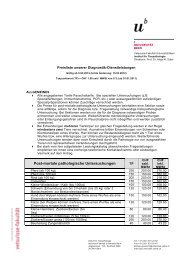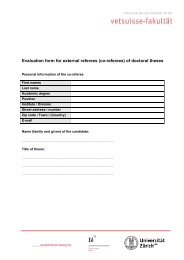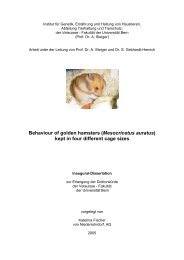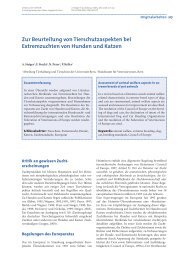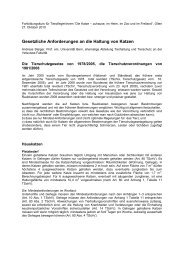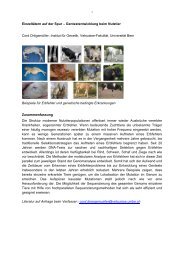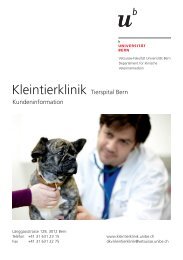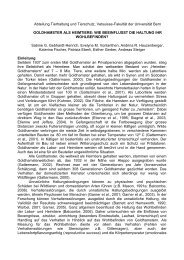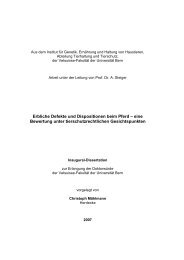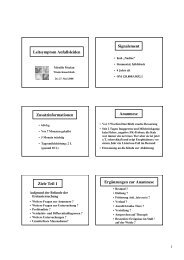Behaviour of golden hamsters (Mesocricetus auratus) kept in four ...
Behaviour of golden hamsters (Mesocricetus auratus) kept in four ...
Behaviour of golden hamsters (Mesocricetus auratus) kept in four ...
You also want an ePaper? Increase the reach of your titles
YUMPU automatically turns print PDFs into web optimized ePapers that Google loves.
85© 2007 Universities Federation for Animal WelfareThe Old School, Brewhouse Hill, Wheathampstead,Hertfordshire AL4 8AN, UKAnimal Welfare 2007, 16: 85-93ISSN 0962-7286<strong>Behaviour</strong> <strong>of</strong> <strong>golden</strong> <strong>hamsters</strong> (<strong>Mesocricetus</strong> <strong>auratus</strong>) <strong>kept</strong> <strong>in</strong> <strong>four</strong>different cage sizesK Fischer † , SG Gebhardt-Henrich* ‡ and A Steiger ‡†Fasanenstrasse 22, CH-4402 Frenkendorf, Switzerland‡Vetsuisse Faculty <strong>of</strong> the University <strong>of</strong> Bern, Division <strong>of</strong> Animal Hous<strong>in</strong>g and Welfare, PO Box Ch-3001, Bern, Switzerland* Contact for correspondence and request for repr<strong>in</strong>ts: sab<strong>in</strong>e.gebhardt@itz.unibe.chAbstractCages for laboratory and pet <strong>hamsters</strong> are usually small. Us<strong>in</strong>g video record<strong>in</strong>gs, the behaviour <strong>of</strong> sixty female <strong>golden</strong> <strong>hamsters</strong>(<strong>Mesocricetus</strong> <strong>auratus</strong>), housed <strong>in</strong>dividually <strong>in</strong> <strong>four</strong> different cage sizes, was compared <strong>in</strong> order to draw conclusions about theirwelfare. The cage sizes were 1,800 cm 2 , 2,500 cm 2 , 5,000 cm 2 , and 10,000 cm 2 . Enrichment items and litter depth were standardisedand all cages were equipped with a runn<strong>in</strong>g-wheel (30 cm diameter). Stereotypic wire-gnaw<strong>in</strong>g, usage <strong>of</strong> the provided space,weight ga<strong>in</strong>, and reactions to mild husbandry stressors were used as welfare <strong>in</strong>dicators. Stereotypic wire-gnaw<strong>in</strong>g was observed <strong>in</strong> allcage sizes, but <strong>hamsters</strong> <strong>in</strong> small cages gnawed significantly longer and more frequently. There were no significant differences <strong>in</strong>runn<strong>in</strong>g-wheel activity. In small cages <strong>hamsters</strong> made use <strong>of</strong> the ro<strong>of</strong> <strong>of</strong> their wooden shelters as an additional platform more <strong>of</strong>tenthan <strong>in</strong> big cages, which could suggest that they needed more space. Therefore, the welfare <strong>of</strong> pet <strong>golden</strong> <strong>hamsters</strong> <strong>in</strong> cages with am<strong>in</strong>imal ground floor area <strong>of</strong> 10,000 cm 2 seemed to be enhanced compared with smaller cages.Keywords: animal welfare, cage size, <strong>golden</strong> hamster, pet animal, runn<strong>in</strong>g-wheel, wire-gnaw<strong>in</strong>gIntroductionGolden <strong>hamsters</strong> (<strong>Mesocricetus</strong> <strong>auratus</strong>) are common laboratoryanimals <strong>in</strong> biomedical research as well as popularpets. Nevertheless, little work has been done with thespecific <strong>in</strong>tent to improve their hous<strong>in</strong>g conditions <strong>in</strong> thelaboratory, and even less is known <strong>of</strong> their hous<strong>in</strong>g requirementsas pets. Exceptions are studies by Bant<strong>in</strong> and Sanders(1989) and Kuhnen (1999a) on cage size, by Mrosovskyet al (1998) on runn<strong>in</strong>g-wheel preferences, by Reebs andMaillet (2003) on environmental enrichment, and the recentreview by Sørensen et al (2005). In the case <strong>of</strong> Kuhnen(1999a), <strong>golden</strong> <strong>hamsters</strong> were <strong>in</strong>dividually housed <strong>in</strong> <strong>four</strong>different cage sizes rang<strong>in</strong>g from 200 to 1,815 cm 2 . Meanfebrile response <strong>in</strong>creased with <strong>in</strong>creas<strong>in</strong>g cage size,whereas mean basel<strong>in</strong>e rectal temperature decreased. Theseresults <strong>in</strong>dicate that hous<strong>in</strong>g <strong>in</strong> small cages <strong>in</strong>duced chronicstress, which affected thermoregulation. The cage sizes usedby Kuhnen (1999a), however, were common for laboratoryrodents but much smaller than the cages used for pet<strong>hamsters</strong>. The Swiss guidel<strong>in</strong>es for pet stores provide a cagesize <strong>of</strong> 1800 cm 2 as the m<strong>in</strong>imum size for <strong>golden</strong> <strong>hamsters</strong>.The Swiss statutory m<strong>in</strong>imum size for one hamster is200 cm 2 . Cage size, ie available space, is <strong>of</strong> great significance<strong>in</strong> regard to the welfare <strong>of</strong> the animals, as shown <strong>in</strong>the studies mentioned above as well as <strong>in</strong> the behaviouraldemand studies by Sherw<strong>in</strong> and Nicol (1997) and Sherw<strong>in</strong>(2003, 2004).Pet rodents spend their whole life <strong>in</strong> their cages and shouldhave the possibility to meet their behavioural needs.Gattermann et al (2001) <strong>in</strong>vestigated the natural habitats <strong>of</strong><strong>golden</strong> <strong>hamsters</strong>. The closest distance between occupiedhamster burrows was 118 m. A mean tunnel length <strong>of</strong>199.5 ± 92.6 cm and a mean burrow depth <strong>of</strong>64.8 ± 17.6 cm were recorded. This shows that the naturalterritory <strong>of</strong> a hamster is considerably larger than any cage.Laboratory <strong>hamsters</strong> did not differ <strong>in</strong> behaviour comparedwith wild caught <strong>hamsters</strong> (Gattermann 2000). Despitedecades <strong>of</strong> domestication they rema<strong>in</strong> capable <strong>of</strong> surviv<strong>in</strong>g<strong>in</strong> a semi-natural environment as demonstrated byGattermann (2000). Therefore, domesticated <strong>hamsters</strong>might need more space than we commonly provide them.Additionally, little is known about the effects <strong>of</strong> handl<strong>in</strong>gand husbandry on the levels <strong>of</strong> stress experienced by pet<strong>hamsters</strong>. In laboratory rodents, rout<strong>in</strong>e handl<strong>in</strong>g andhusbandry procedures have been recognised as potentialstress factors (Balcombe et al 2004). Pet <strong>hamsters</strong> arefrequently caught out <strong>of</strong> their cages by their owners andcarried around. Also, cages are regularly cleaned and movedaround. It is to be expected that <strong>hamsters</strong> <strong>kept</strong> as pets arealso subjected to stressors comparable to rout<strong>in</strong>e handl<strong>in</strong>gprocedures <strong>in</strong> laboratory <strong>hamsters</strong>. Therefore, we also<strong>in</strong>cluded mild husbandry stressors such as handl<strong>in</strong>g andpush<strong>in</strong>g cages around <strong>in</strong> our study. The aim <strong>of</strong> this studywas to analyse behavioural differences <strong>of</strong> <strong>golden</strong> <strong>hamsters</strong>housed <strong>in</strong> different sized cages and subjected to mildUniversities Federation for Animal WelfareScience <strong>in</strong> the Service <strong>of</strong> Animal Welfare
86 Fischer et alFigure 1Timetable <strong>of</strong> the experiment. The stresstreatment was conducted dur<strong>in</strong>g theweeks 11 and 12.husbandry rout<strong>in</strong>e stressors and to draw conclusions abouttheir welfare. <strong>Behaviour</strong> can be a good <strong>in</strong>dicator for thestate <strong>of</strong> welfare <strong>in</strong> animals (Mason 1991; Mason & Mendl1993; but see Mason & Latham 2004). The welfare <strong>of</strong>captive <strong>hamsters</strong> can be assessed by measur<strong>in</strong>g thefrequency and duration <strong>of</strong> wire-gnaw<strong>in</strong>g. Wire-gnaw<strong>in</strong>g <strong>in</strong>mice seems to <strong>in</strong>dicate the <strong>in</strong>tention <strong>of</strong> break<strong>in</strong>g-out <strong>of</strong> thecage to explore the environment (Würbel et al 1998a, b;Nevison et al 1999). It is common <strong>in</strong> <strong>golden</strong> <strong>hamsters</strong> <strong>kept</strong><strong>in</strong> captivity (Gebhardt-Henrich et al 2005). The more ahamster performs this, the more welfare could be compromised.Physiological measurements, such as adrenalhormones and adrenal weight can also <strong>in</strong>dicate stress andwelfare <strong>of</strong> the <strong>golden</strong> hamster. Dur<strong>in</strong>g chronic stress,adrenal weight is <strong>in</strong>creased due to <strong>in</strong>creased hormonalproduction and can, therefore, be a helpful physiologicalparameter <strong>of</strong> stress measurement (Zimmer & Gattermann1986). S<strong>in</strong>ce the study focused especially on pet <strong>hamsters</strong>,cage sizes considerably larger than common laboratorycages were used. Areas <strong>of</strong> cages used <strong>in</strong> this study rangedfrom 1,800 cm 2 to 10,000 cm 2 . The area <strong>of</strong> the smallest cagewas chosen because it provided the m<strong>in</strong>imum for <strong>golden</strong><strong>hamsters</strong> <strong>in</strong> the Swiss pet shop guidel<strong>in</strong>es. An area <strong>of</strong>2,500 cm 2 is a common size for a hamster cage. The SwissAnimal Protection Society (STS) demands a m<strong>in</strong>imum area<strong>of</strong> 5,000 cm 2 and they recommend a cage <strong>of</strong> more than10,000 cm 2 (Lerch-Leemann 2002). In order to reducevariation due to sex, only one sex (female) <strong>hamsters</strong>were used.Materials and methodsAnimals and hous<strong>in</strong>g conditionsThe sixty female <strong>golden</strong> <strong>hamsters</strong> used for this study wereprogeny <strong>of</strong> the stra<strong>in</strong> Crl: LVG (SYR) from Charles River,Germany. Dur<strong>in</strong>g one year the sixty <strong>hamsters</strong> were bred <strong>in</strong>three series <strong>of</strong> 20 <strong>hamsters</strong> each. We used 17 dams and9 sires. The age difference <strong>of</strong> <strong>hamsters</strong> <strong>in</strong> one series wasmostly <strong>four</strong> days, up to a maximum <strong>of</strong> seven. A photoperiod<strong>of</strong> 12 h light, 12 h dark, dawn at 1300h was ma<strong>in</strong>ta<strong>in</strong>ed.Room temperature was 21 ± 2°C, relative humidity was notregulated, but ranged from 25 to 59%. Hamsters used <strong>in</strong> thisstudy were born and raised <strong>in</strong> cages with a wire top and adark blue opaque plastic dishpan as the bottom(95 × 57 × 45 cm; length × breadth × height) without arunn<strong>in</strong>g-wheel. Between 24 and 30 days <strong>of</strong> age, they wereplaced s<strong>in</strong>gly <strong>in</strong>to <strong>four</strong> differently sized cages: Size 1 was32 × 57 × 45 cm (length × breadth × height), ie 1,800 cm 2 ;size 2, 44 × 57 × 45 cm ie 2,500 cm 2 ; size 3, 95 × 57 × 45 cmie 5,000 cm 2 and size 4, 105 × 95 × 45 cm ie 10,000 cm 2 . Allcages were furnished with a wooden shelter(20 × 14 × 14 cm) with one entrance <strong>in</strong> front, litter (15 cmdeep wood shav<strong>in</strong>gs), hay, paper-towels, cardboard tubes,twigs, a sand-bath (diameter: 16 cm, ch<strong>in</strong>chilla sand) and arunn<strong>in</strong>g-wheel (diameter: 30 cm, width <strong>of</strong> perforated metalplate runn<strong>in</strong>g surface: 10 cm). Commercial pet hamster food(Witte Molen®, NL-Meeuwen) and water were <strong>of</strong>feredad libitum. This diet was supplemented by dry cat food andvitam<strong>in</strong> and m<strong>in</strong>eral supplements (Marienfelde Vitakalk). Inaddition, fresh fruits and vegetables were <strong>of</strong>fered daily.Litter was never changed completely. Only the dirty parts <strong>of</strong>the litter were replaced when necessary. Due to spacerestrictions, the experiments were performed <strong>in</strong> three series.Five cages <strong>of</strong> each size were used simultaneously. In each<strong>of</strong> the three series, 20 <strong>hamsters</strong> were distributed s<strong>in</strong>gly <strong>in</strong>the 20 cages. If possible, <strong>hamsters</strong> <strong>of</strong> one litter were placedrandomly <strong>in</strong>to all sizes, but the distribution was balancedaccord<strong>in</strong>g to their body mass <strong>in</strong> cages <strong>of</strong> <strong>four</strong> different sizes.The experiment was approved by the Cantonal Veter<strong>in</strong>aryOffice, Herrengasse 1, CH-3011, Berne, Switzerland.Procedure and measurementsProcedureIn week 0, at wean<strong>in</strong>g, the <strong>hamsters</strong> were approximately4 weeks <strong>of</strong> age. Dur<strong>in</strong>g the experiment they were weighedand videotaped on several occasions (Figure 1).In weeks 11 and 12 each hamster was stressed on twoconsecutive days. At 17 weeks <strong>of</strong> age, the <strong>hamsters</strong> weredecapitated after is<strong>of</strong>lurane-anaesthesia. The stresstreatment started with strongly shak<strong>in</strong>g the cage <strong>in</strong> a mannerthat the hamster was certa<strong>in</strong>ly woken up and probably upset.The animal was then chased briefly and handled for about30 – 60 seconds once caught. Handl<strong>in</strong>g consisted <strong>of</strong> pett<strong>in</strong>gand hold<strong>in</strong>g the hamster which was always keen to retreat.After handl<strong>in</strong>g, the hamster was placed <strong>in</strong>to a smallcardboard box for 30 m<strong>in</strong> and exposed to loud music forthree to five m<strong>in</strong>utes before be<strong>in</strong>g returned to its cage.© 2007 Universities Federation for Animal Welfare
Cage size for <strong>hamsters</strong> 87Figure 2Duration <strong>of</strong> behaviours <strong>in</strong> percent <strong>of</strong> total duration <strong>in</strong> the different cage sizes: a) wheel-runn<strong>in</strong>g, b) rest<strong>in</strong>g, c) rear<strong>in</strong>g, d) groom<strong>in</strong>g, e)wire-gnaw<strong>in</strong>g, f) feed<strong>in</strong>g, g) runn<strong>in</strong>g, h) gnaw<strong>in</strong>g, i) climb<strong>in</strong>g, j) digg<strong>in</strong>g, k) dr<strong>in</strong>k<strong>in</strong>g.Additionally, on the first day <strong>of</strong> stress, half <strong>of</strong> the litter waschanged while, on the second day, a confrontation withanother hamster was <strong>in</strong>stigated. At the end <strong>of</strong> the experiment,immediately prior to euthanasia, the anaesthetisedanimal was stretched out on a ruler and body length (snoutto tip <strong>of</strong> tail) was measured. The body condition <strong>of</strong> thehamster was calculated as bodyweight relative to bodylength (bodyweight at week 13/length 3 ); as a degree <strong>of</strong>adiposis. Blood was collected and analysed for corticosterone,cortisol and ACTH. After dissection the adrenalglands, heart, and spleen were weighed and the gastricmucosa was exam<strong>in</strong>ed for ulcers. As a precaution, all bra<strong>in</strong>swere exam<strong>in</strong>ed for hydrocephalus <strong>in</strong>ternus, as the conditionwas prevalent <strong>in</strong> the colony, although without anydetectable behavioural changes (Edwards et al 2006).Runn<strong>in</strong>g-wheel activityRevolutions <strong>of</strong> runn<strong>in</strong>g-wheels were constantly registeredby the Chronobiology Kit (Stanford S<strong>of</strong>tware Systems).For the analysis <strong>of</strong> the runn<strong>in</strong>g-wheel activity we used themedian <strong>of</strong> the daily revolutions until week 10, prior tostress<strong>in</strong>g the <strong>hamsters</strong>. For the analysis <strong>of</strong> the effects <strong>of</strong> mildstressors, the mean number <strong>of</strong> revolutions dur<strong>in</strong>g the 2 daysthese stressors were applied, as described above, as well as2 days before and after application, were compared.<strong>Behaviour</strong>The behaviour <strong>of</strong> the <strong>hamsters</strong> was recorded 3 times <strong>in</strong>weeks 3, 6 and 10 by us<strong>in</strong>g a light sensitive camera(Ikegami ICD-47E) and a video recorder (Panasonic AG-6730) from 1430 until 1730h. The highest level <strong>of</strong> activityoccurred dur<strong>in</strong>g this period (Fischer personal observation2004). A total <strong>of</strong> thirty m<strong>in</strong>utes <strong>of</strong> active behaviour perrecord<strong>in</strong>g, dur<strong>in</strong>g which period the hamster stayed outsidethe shelter, ie the subject was awake and clearly visible, wasanalysed us<strong>in</strong>g the Observer Version 5.0 (Noldus). Thethirty m<strong>in</strong>utes were split <strong>in</strong>to six × five-m<strong>in</strong>ute observation<strong>in</strong>tervals. If possible, the <strong>in</strong>tervals were equally spaced overthe three recorded hours. If observation <strong>in</strong>tervals could notbe equally spaced over the 3 hours <strong>of</strong> record<strong>in</strong>g, a total <strong>of</strong>thirty m<strong>in</strong>utes, ie 6 <strong>in</strong>tervals <strong>of</strong> the time when the <strong>hamsters</strong>were visible on the tape would, nonetheless, still beanalysed. In some cases 4% (7 <strong>hamsters</strong>, each with 1 observation)<strong>of</strong> <strong>hamsters</strong> were active for less than 30 m<strong>in</strong>utesdur<strong>in</strong>g 3 hours <strong>of</strong> record<strong>in</strong>g, therefore their observationalAnimal Welfare 2007, 16: 85-93
88 Fischer et alTable 1 Post hoc comparisons <strong>of</strong> runn<strong>in</strong>g-wheel activity 2 days before (2BS), 2 days dur<strong>in</strong>g (2DS) and 2 days after (2AS)stressor application.Comparison T-Value P-Value Revolutions per day2AS vs 2BS and 2DS 3.2059 0.0018232AS vs 2BS 2.2127 0.029267 +11882AS vs 2DS 3.3436 0.001177 +2115.362BS vs 2DS 1.1617 0.248200 +927.36The number <strong>of</strong> revolutions per day <strong>in</strong>dicate how many additional revolutions on average <strong>hamsters</strong> made dur<strong>in</strong>g the <strong>in</strong>dicated 2 days (firstcolumn first term <strong>in</strong> comparison with the other two days (first column second term).Table 2 Number <strong>of</strong> <strong>hamsters</strong> mak<strong>in</strong>g use <strong>of</strong> the ro<strong>of</strong> <strong>of</strong> their wooden shelter.Cage size (cm 2 ) Observed on shelter Not observed on shelter n1,800 14 1 152,500 12 2 145,000 5 10 1510,000 4 11 15Total 35 24 59(χ 2 3= 22.05, P < 0.0001). One hamster whose wheel was non-function<strong>in</strong>g was deleted.Table 3 The mean (± SD) concentrations <strong>of</strong> hormones <strong>in</strong> the serum <strong>of</strong> female <strong>golden</strong> <strong>hamsters</strong> <strong>in</strong> 4 different cagesizes.Cage size (cm 2 ) n Corticosterone(ng ml –1 )Cortisol(ng ml –1 )Corticosterone/cortisolcoefficientACTH(pg ml –1 )1,800 14 7.74 ± 5.43 8.94 ± 6.64 1.34 ± 0.94 9.64 ± 15.312,500 13 7.41 ± 4.48 8.88 ± 6.12 1.73 ± 1.56 12.85 ± 11.105,000 15 7.44 ± 5.10 8.25 ± 7.21 1.79 ± 2.67 15.20 ± 13.4310,000 14 6.76 ± 3.51 7.29 ± 6.67 1.26 ± 1.14 13.00 ± 14.61Table 4 The mean (± SD) masses <strong>of</strong> organs <strong>of</strong> female <strong>golden</strong> <strong>hamsters</strong> <strong>in</strong> 4 different cage sizes.Cage size (cm 2 ) n Adrenals (µg) Heart (mg) Spleen (mg)1,800 14 7.98 ± 1.67 0.53 ± 0.07 0.14 ± 0.032,500 13 8.22 ± 2.33 0.54 ± 0.06 0.13 ± 0.015,000 15 9.01 ± 2.27 0.53 ± 0.07 0.03 ± 0.0210,000 15 8.54 ± 2.18 0.50 ± 0.05 0.18 ± 0.22data was based purely on the time they were active. As one<strong>of</strong> the <strong>hamsters</strong> <strong>in</strong> cage size 2 was never active dur<strong>in</strong>g therecorded time, behavioural data for this animal are miss<strong>in</strong>g.The <strong>hamsters</strong> were observed cont<strong>in</strong>uously and the observedbehaviours, and locations <strong>of</strong> behaviours with<strong>in</strong> the cage,were classified follow<strong>in</strong>g Vonlanthen (2003). <strong>Behaviour</strong>aldata were expressed as the percentage <strong>of</strong> total observedtime, ie 90 m<strong>in</strong>, for all three record<strong>in</strong>gs (total percentduration). Furthermore, mean durations <strong>of</strong> bouts, andfrequencies <strong>of</strong> bouts were analysed. The open space <strong>of</strong> acage was def<strong>in</strong>ed as the area <strong>of</strong> the cage exclud<strong>in</strong>g anystructures like the runn<strong>in</strong>g-wheel, shelter, food bowl, sandbath, or wire.Statistical analysesAll statistical analyses were made with NCSS® 2001, orSAS® 8.02 (SAS Institute, Cary, NC). Data and residualswere checked for normality and transformed if necessaryand possible. If normality <strong>of</strong> residuals could not beachieved, non-parametric tests were used. Transformationsand tests are described <strong>in</strong> the results. Experimental series (1-3) and the occurrence <strong>of</strong> hydrocephalus were <strong>in</strong>cluded asfactors <strong>in</strong> the analyses <strong>of</strong> behavioural data and are onlymentioned if they had a significant <strong>in</strong>fluence. Correlationswere calculated by us<strong>in</strong>g Spearman rank correlation coefficients.One hamster was excluded from the behaviouralanalyses s<strong>in</strong>ce her wheel was malfunction<strong>in</strong>g over a long© 2007 Universities Federation for Animal Welfare
Cage size for <strong>hamsters</strong> 89Figure 3Frequency dur<strong>in</strong>g 30 m<strong>in</strong> observationsdur<strong>in</strong>g the active time <strong>of</strong> wire-gnaw<strong>in</strong>gbouts <strong>of</strong> <strong>in</strong>dividual <strong>hamsters</strong> <strong>in</strong> the differentcage sizes. Raw data are shown, butfor the analyses the data were squareroot transformed.Figure 4Duration <strong>of</strong> wire-gnaw<strong>in</strong>g (% <strong>of</strong> the totalobservation duration) <strong>in</strong> the 4 cage sizes.Boxes represent the central 50% <strong>of</strong> thedata, the horizontal l<strong>in</strong>e represents themedian, the vertical l<strong>in</strong>es show 1.5 timesthe <strong>in</strong>terquartile range, dots are valuesoutside this range, and stars representthe mean value <strong>of</strong> total duration whichwas 19.3% for 1,800 cm 2 , 14.5% for2,500 cm 2 , 9.55% for 5,000 cm 2 , and 4.2%for 10,000 cm 2 . Raw data are shown, forthe analyses the data were transformedas per Figure 3.period <strong>of</strong> the experiment, which could have had an<strong>in</strong>fluence on her behaviour.Results<strong>Behaviour</strong>Hamsters devoted most <strong>of</strong> their active behaviour to wheelrunn<strong>in</strong>g.The rema<strong>in</strong><strong>in</strong>g time was spent ma<strong>in</strong>ly on rest<strong>in</strong>g,rear<strong>in</strong>g and groom<strong>in</strong>g (Figure 2).The results <strong>of</strong> the different behavioural activities are listedbelow. The occurrence <strong>of</strong> hydrocephalus as a ma<strong>in</strong> factorwas never significant. There was no immediate <strong>in</strong>fluence <strong>of</strong>the stressors on the behaviour <strong>of</strong> the <strong>hamsters</strong>.Runn<strong>in</strong>g-wheel useAll <strong>hamsters</strong> used the runn<strong>in</strong>g-wheel. The average distancewas 8.3 km per day (8872 revolutions). The m<strong>in</strong>imum peranimal was on average 0.63 km per day; the maximum was18.56 km per day. These distances are not equivalent tolocomotion <strong>in</strong> a cage or <strong>in</strong> the natural habitat (Sherw<strong>in</strong>1998a). Dur<strong>in</strong>g the 10 weeks before the stress treatment,runn<strong>in</strong>g-wheel activity <strong>of</strong> <strong>hamsters</strong> was not significantlydifferent <strong>in</strong> all 4 cage sizes (ANOVA, F = 0.88, n = 59, ns).However, the more a hamster ran <strong>in</strong> the wheel, the less itgnawed at the wire (r s= –0.7105, n = 59, P < 0.0001) orclimbed (r s= –0.7261, n = 59, P < 0.0001). The runn<strong>in</strong>g-Animal Welfare 2007, 16: 85-93
90 Fischer et alFigure 5Mixed model REML <strong>of</strong> weight ga<strong>in</strong> fromwean<strong>in</strong>g to week 13 with cage size andseries as factor variables. Raw data areshown, for the analysis the data were logtransformed. In a pairwise comparison, thedifference between the smallest and thelargest cages was significant (P < 0.05).wheel data dur<strong>in</strong>g the two days <strong>of</strong> stress and the runn<strong>in</strong>gwheeldata <strong>of</strong> the two days after the stress treatment werethen compared with the runn<strong>in</strong>g-wheel activity on the twodays before the stress was applied.The stress treatment affected runn<strong>in</strong>g-wheel activity significantly<strong>in</strong> all cage sizes. Dur<strong>in</strong>g the two days after stresstreatment, runn<strong>in</strong>g-wheel activity was significantly higherthan before and dur<strong>in</strong>g stressor application (RepeatedMeasures ANOVA, n = 45, P = 0.0068, F = 5.31) (Table 1).From time-to-time some <strong>hamsters</strong> blocked the runn<strong>in</strong>gwheelwith litter and <strong>in</strong> certa<strong>in</strong> <strong>in</strong>stances the runn<strong>in</strong>g-wheelwas not function<strong>in</strong>g or the transmission <strong>of</strong> data failed. Thesedata were excluded from the analyses. Furthermore, allrunn<strong>in</strong>g-wheel data <strong>of</strong> one hamster <strong>in</strong> cage size 2 wereexcluded because the transmission <strong>of</strong> the runn<strong>in</strong>g-wheeldata failed consistently.The total duration <strong>of</strong> wheel-runn<strong>in</strong>g observed <strong>in</strong> the record<strong>in</strong>gswas significantly correlated with the median <strong>of</strong> therevolutions per day measured with the Chronobiology Kit(r s= 0.60, n = 58, P < 0.0001).Wire-gnaw<strong>in</strong>gCompared with gnaw<strong>in</strong>g at various structures (cardboardtube, twigs, shelter, etc) the <strong>hamsters</strong> gnawed at the wire forlonger periods (Wilcoxon Signed Rank Test: Z = 4.3439,P < 0.0001). The mean duration <strong>of</strong> wire-gnaw<strong>in</strong>g was7.6 ± 2.7 s and the mean duration <strong>of</strong> gnaw<strong>in</strong>g at other structureswas 0.9 ± 0.7 s. While 13 out <strong>of</strong> 59 (22%) <strong>hamsters</strong>showed both behaviours, 17 (29%) showed only wiregnaw<strong>in</strong>g,3 (5%) gnawed exclusively on other material thanwire, and 26 <strong>hamsters</strong> were never observed gnaw<strong>in</strong>g onanyth<strong>in</strong>g. There was no significant effect <strong>of</strong> cage size on thenumber <strong>of</strong> <strong>hamsters</strong> perform<strong>in</strong>g wire-gnaw<strong>in</strong>g. For furtheranalyses a m<strong>in</strong>imum threshold for duration (1% <strong>of</strong> totalobserved time) was def<strong>in</strong>ed to exclude <strong>hamsters</strong> that onlybit <strong>in</strong>to the bars briefly. Hamsters <strong>in</strong> small cages gnawedmore frequently at the wire than <strong>hamsters</strong> <strong>in</strong> larger cages(ANOVA, square root transformation: n = 22, F = 3.35,P = 0.05) (Figure 3).Total duration <strong>of</strong> wire-gnaw<strong>in</strong>g was significantly longer <strong>in</strong>small cages (Mixed model us<strong>in</strong>g REML, transformationy 1 = 2 ars<strong>in</strong>√y: n = 22, F = 14.00, P = 0.002) (Figure 4).Compar<strong>in</strong>g the smallest and the biggest cage size the differencewas significant (Tukey’s Studentized Range Test forpercent duration: P < 0.05). Furthermore, wire-gnaw<strong>in</strong>g waspositively correlated with climb<strong>in</strong>g (Spearman rank correlationcoefficient [r s] = 0.7180, n = 59, P < 0.0001), which<strong>in</strong>dicates that <strong>hamsters</strong> that used to gnaw on the wire alsoused to climb on the wire. Total duration <strong>of</strong> wire-gnaw<strong>in</strong>gwas positively correlated with f<strong>in</strong>al bodyweight (r s= 0.43,n = 22, P = 0.04).LocationHamsters spent most <strong>of</strong> their active time <strong>in</strong>side the runn<strong>in</strong>gwheel(58% <strong>in</strong> 1,800 cm 2 , 74% <strong>in</strong> 2,500 cm 2 ,63% <strong>in</strong> 5,000 cm 2 and 70% <strong>in</strong> 10,000 cm 2 ) (Figure 2). Thesedifferences were not significant. The rema<strong>in</strong><strong>in</strong>g time wasspent <strong>in</strong> the open space, at the wire, <strong>in</strong> the food bowl, on theshelter, or <strong>in</strong> the sand-bath. In small cages, more <strong>hamsters</strong>were observed at least once on top <strong>of</strong> the ro<strong>of</strong> <strong>of</strong> their shelter(Fisher’s Exact Test, n = 59, χ 2 = 22.05, P < 0.0001) (see3Table 2), but the total duration on top <strong>of</strong> shelters as well asthe total frequency <strong>of</strong> shelter ro<strong>of</strong> use did not differ amongcage sizes (ANOVAS, all P > 0.1).The use <strong>of</strong> the open space was much more pronounced <strong>in</strong>big cages (ANOVA, n = 59, P = 0.0187, F = 3.66). Thewhole area <strong>of</strong> all the cages was used regularly.© 2007 Universities Federation for Animal Welfare
Cage size for <strong>hamsters</strong> 91BodyweightAt week 0 bodyweights did not differ significantly <strong>in</strong> all<strong>four</strong> cage sizes (ANOVA, log-transformation: n = 60,F = 2.65, P = 0.14). Weight ga<strong>in</strong> from wean<strong>in</strong>g untilweek 13 was significantly reduced <strong>in</strong> big cages (Mixedmodel on log-transformed weight ga<strong>in</strong>s: n = 57, P = 0.01,F 3, 32= 4.53) (Figure 5). Series, age at wean<strong>in</strong>g, and littersize had no effect on weight ga<strong>in</strong>. Body condition also didnot differ significantly between cage sizes (ANOVA:n = 57, F = 1.93, P = 0.14). Dur<strong>in</strong>g autopsy, no difference<strong>in</strong> the amount <strong>of</strong> fatty tissue was noticed.Stress hormones and organ weightsNeither plasma stress hormone levels nor the coefficient <strong>of</strong>cortisol/corticosterone differed between cage sizes (P > 0.1)(Table 3). No differences were found <strong>in</strong> organ weights<strong>in</strong>clud<strong>in</strong>g the weights <strong>of</strong> the adrenal glands (Table 4).DiscussionThe aim <strong>of</strong> this study was to analyse behavioural differences<strong>of</strong> <strong>golden</strong> <strong>hamsters</strong> housed <strong>in</strong> different sized cages andsubjected to mild husbandry rout<strong>in</strong>e stressors and to drawconclusions about their welfare. Size related differences <strong>in</strong>wire-gnaw<strong>in</strong>g, use <strong>of</strong> the ro<strong>of</strong> <strong>of</strong> their shelter as additionalspace, use <strong>of</strong> open space, and weight ga<strong>in</strong> <strong>in</strong>dicated reducedwelfare <strong>in</strong> small cages. Our <strong>in</strong>vestigations showed that,although <strong>hamsters</strong> displayed wire-gnaw<strong>in</strong>g <strong>in</strong> all cage sizes,<strong>hamsters</strong> <strong>in</strong> small cages performed wire-gnaw<strong>in</strong>g more<strong>of</strong>ten and for longer periods. In small cages, more <strong>hamsters</strong>made use <strong>of</strong> the ro<strong>of</strong> <strong>of</strong> their shelter which could <strong>in</strong>dicatethat additional space was <strong>in</strong>creas<strong>in</strong>g welfare. The use <strong>of</strong>open space was much more pronounced <strong>in</strong> larger cages andthe whole area <strong>of</strong> the larger cages was used regularly. Thecage size did not <strong>in</strong>fluence runn<strong>in</strong>g-wheel activity <strong>of</strong><strong>hamsters</strong>. This was expected because rodents value wheelrunn<strong>in</strong>gvery much as shown <strong>in</strong> an operant test with mice(Sherw<strong>in</strong> 1998b).Hamsters gnawed longer and more frequently on the wirethan on other objects <strong>in</strong> their cage. Gnaw<strong>in</strong>g on cardboardtubes, twigs or the wooden shelter serves several purposes,such as help<strong>in</strong>g abrasion and clean<strong>in</strong>g <strong>of</strong> the teeth and alsoto produce nest<strong>in</strong>g material, provide food fibre, etc (Fischerpersonal observation 2004). Some <strong>hamsters</strong> shredded thecardboard tube and used its pieces as nest<strong>in</strong>g material. Incontrast, wire-gnaw<strong>in</strong>g seemed to be <strong>in</strong>effective; it couldnot be prevented by provid<strong>in</strong>g natural material to chew on,so wire-gnaw<strong>in</strong>g and gnaw<strong>in</strong>g at objects presumably have adifferent cause and/or function. Wire-gnaw<strong>in</strong>g might be anattempt to escape from the cage (Nevison et al 1999,Würbel et al 1998a, b), but it can also be <strong>in</strong>terpreted as redirectedbehaviour at a replacement object and thus as anabnormal behaviour, or even as a stereotypy. Stereotypicbehaviour is commonly def<strong>in</strong>ed as repetitive, unvary<strong>in</strong>gbehavioural patterns without obvious goal or function(Ödberg 1987), <strong>in</strong> animals <strong>kept</strong> under barren hous<strong>in</strong>g conditions(Mason 1991). Stereotypies are <strong>of</strong>ten observed <strong>in</strong>captive rodents (Würbel & Stauffacher 1996, 1997, 1998;Wiedenmayer 1997; Waibl<strong>in</strong>ger 1999) and are common<strong>in</strong>dicators <strong>of</strong> poor welfare (eg review by Mason 1991;Würbel 2001). Wire-gnaw<strong>in</strong>g <strong>in</strong> <strong>hamsters</strong> <strong>in</strong> the presentstudy was repetitive, <strong>in</strong>variant, performed at a particularspot on the wire top <strong>of</strong> the cage (Würbel et al 1996), andwithout function. Even if this behaviour is not considered astereotypy but an attempt to escape from the cage, it is stillan <strong>in</strong>dication that the wire-gnaw<strong>in</strong>g <strong>hamsters</strong> were notcontent with their hous<strong>in</strong>g.Therefore, the results <strong>of</strong> this study <strong>in</strong>dicated that hous<strong>in</strong>g <strong>in</strong>big cages improved the welfare <strong>of</strong> the <strong>hamsters</strong> because itresulted <strong>in</strong> less wire-gnaw<strong>in</strong>g. The biggest cage, with a size<strong>of</strong> 10,000 cm 2 , was the one with the shortest duration <strong>of</strong>wire-gnaw<strong>in</strong>g as well as the lowest frequency. Duration andfrequency <strong>of</strong> wire-gnaw<strong>in</strong>g <strong>in</strong> 10,000 cm 2 was half <strong>of</strong> thatseen <strong>in</strong> 5,000 cm 2 cages, albeit non-significantly. However,even though <strong>hamsters</strong> <strong>in</strong> small cages performed more wiregnaw<strong>in</strong>gthan <strong>hamsters</strong> housed <strong>in</strong> bigger cages, wiregnaw<strong>in</strong>goccurred <strong>in</strong> all cages. This suggests that even acage <strong>of</strong> 10,000 cm 2 was too small for female <strong>golden</strong><strong>hamsters</strong>. If we estimate the natural territory size from them<strong>in</strong>imum distance between occupied burrows <strong>in</strong> Syria, ourbiggest cages represented a mere 0.007% <strong>of</strong> it.The positive correlation between wire-gnaw<strong>in</strong>g andclimb<strong>in</strong>g can be expla<strong>in</strong>ed by the preference <strong>of</strong> some<strong>hamsters</strong> to climb to a particular spot on the front or the top<strong>of</strong> the cage to gnaw on the wire. Some <strong>hamsters</strong> used toclimb while paus<strong>in</strong>g dur<strong>in</strong>g wire-gnaw<strong>in</strong>g. They usuallyclimbed up and down the front side <strong>of</strong> the wire top but thenreturned to the same po<strong>in</strong>t and restarted wire-gnaw<strong>in</strong>g.Climb<strong>in</strong>g was considered as the source behaviour pattern<strong>of</strong> stereotypic wire-gnaw<strong>in</strong>g <strong>in</strong> laboratory mice (Würbelet al 1996).In addition to behavioural observations, physiologicalparameters could be useful to assess the welfare <strong>of</strong> the<strong>golden</strong> <strong>hamsters</strong>. The health <strong>of</strong> the animals is an importantfactor for welfare. Obesity and its negative consequencesare common <strong>in</strong> pets. Therefore it is important to give<strong>hamsters</strong> the appropriate cage size, where the risk <strong>of</strong> obesityis m<strong>in</strong>imised. Possible reasons for the higher weight ga<strong>in</strong> <strong>in</strong>small cages could be lower energy expenditure and/orgreater food <strong>in</strong>take. Faster runn<strong>in</strong>g <strong>in</strong> big cages, which usesmore energy, would expla<strong>in</strong> the higher energy consumption.Hamsters <strong>in</strong> smaller cages ga<strong>in</strong>ed more weight and wereobviously able to spend more energy on growth. At anadvanced age excessive energy will not be used for growth,at which po<strong>in</strong>t adiposis could become a problem <strong>in</strong> smallcages. The lack <strong>of</strong> a runn<strong>in</strong>g-wheel or other activities withthe possibility for high energy expenditure, could further<strong>in</strong>crease adiposis. Therefore, cage sizes 1 and 2 seem tohave been too small for the hous<strong>in</strong>g <strong>of</strong> pet <strong>hamsters</strong>.The lack <strong>of</strong> significant differences <strong>in</strong> hormonal levels couldbe due to methodological problems (Gebhardt-Henrich et alsubmitted). Due to the sensitivity <strong>of</strong> hormonal measurementsto (sometimes unknown and unavoidable) environmentalfactors, <strong>in</strong>terpretations <strong>of</strong> the stress levels <strong>of</strong> <strong>golden</strong><strong>hamsters</strong> based on these hormones must be made withcaution. It is probable that several problems contribute toAnimal Welfare 2007, 16: 85-93
92 Fischer et althe difficulties <strong>of</strong> <strong>in</strong>terpret<strong>in</strong>g hormonal measurements withregard to stress and these have been discussed sufficientlyelsewhere (Buchanan & Goldsmith 2004; Rushen 1991).However, the measurements <strong>of</strong> adrenal glands suggest thatstress levels did not differ between cage sizes. The stressexperienced as a result <strong>of</strong> common disturbances, mimickedby our stressor treatments, might not be <strong>in</strong>fluenced by thesize <strong>of</strong> the cage. Alternatively, 13 weeks <strong>in</strong> the differentcages might not have been sufficient to result <strong>in</strong> differentlysized adrenal glands. The lack <strong>of</strong> any significant effect <strong>of</strong>stressors on behaviour could also mean that the stressorswere not strong enough to elicit a response. However, thestress treatment <strong>in</strong>creased (short-term) runn<strong>in</strong>g <strong>in</strong> the wheel.There are numerous <strong>in</strong>terpretations <strong>of</strong> the causes <strong>of</strong>runn<strong>in</strong>g-wheel activity (see the review by Sherw<strong>in</strong> 1998a).A possible explanation is that the situation dur<strong>in</strong>g the stresstreatment was aversive to the <strong>hamsters</strong> and they tried toescape from the area. Runn<strong>in</strong>g <strong>in</strong> the wheel might haveprovided the illusion that they could leave the area. Thepossibility that runn<strong>in</strong>g <strong>in</strong> the wheel helped reduce experiencedstress is one that lies beyond the scope <strong>of</strong> this paperand rema<strong>in</strong>s the subject <strong>of</strong> an ongo<strong>in</strong>g study.Compared with other studies, all cages <strong>in</strong> our study wereenriched. All cages were furnished with the same structures(enrichment), but there was still more free space <strong>in</strong> bigcages. In big cages, <strong>hamsters</strong> had the possibility to runlonger distances, whereas enrichment items and the chanceto perform other behaviours were the same <strong>in</strong> all cages. Itwould be <strong>in</strong>terest<strong>in</strong>g to see whether stereotypic wiregnaw<strong>in</strong>gwould persist <strong>in</strong> big cages with more enrichment.Ödberg (1987) found that an <strong>in</strong>crease <strong>in</strong> cage size did notaffect stereotyped jump<strong>in</strong>g <strong>in</strong> voles, whereas enrichmentwith twigs reduced it. Although jump<strong>in</strong>g is not analagous towire-gnaw<strong>in</strong>g <strong>in</strong> <strong>hamsters</strong> it shows that the structure <strong>of</strong> theenvironment can be <strong>of</strong> greater importance to caged animalsthan the size <strong>of</strong> the cage. Spangenberg et al (2005) housedrats either s<strong>in</strong>gly <strong>in</strong> small cages (1,092 cm 2 ) with only oneblack plastic tube, or <strong>in</strong> groups <strong>in</strong> larger cages (3,938 cm 2 )which were provided with more and various enrichment.Rats <strong>in</strong> larger, more enriched cages displayed a morediverse behavioural repertoire which consisted <strong>of</strong> runn<strong>in</strong>g,climb<strong>in</strong>g and social behaviours. The size <strong>of</strong> a cage andenrichment are not <strong>in</strong>dependent. Big cages <strong>of</strong>fer more possibilitiesand space for enrichment than small cages. Moreenrichment items might lead to less stereotypic behaviourand improve animal welfare (eg Ödberg 1987; Würbel et al1998; Kuhnen 1999b). The comb<strong>in</strong>ation <strong>of</strong> a big cage witha correspond<strong>in</strong>g amount <strong>of</strong> enrichment could be an evenbigger improvement <strong>of</strong> welfare <strong>in</strong> <strong>golden</strong> <strong>hamsters</strong>.The well-be<strong>in</strong>g <strong>of</strong> caged animals is affected by manyfactors (Bant<strong>in</strong> & Sanders 1989). Weiss and Schtick 1982(<strong>in</strong> Bant<strong>in</strong> & Sanders 1989) showed that rats prefer to live<strong>in</strong> big, narrow cages compared to big, broad cages.Although our cages were much bigger than the cages <strong>in</strong>the mentioned study, the shape <strong>of</strong> the cage could also beimportant for <strong>hamsters</strong>.The available free space was used <strong>in</strong> all cage sizes.Hamsters <strong>in</strong> the two bigger cages used the whole groundarea and spent more time <strong>in</strong> the open space than <strong>hamsters</strong> <strong>in</strong>the two smaller cages. However, the <strong>hamsters</strong> <strong>in</strong> the twobigger cages used to walk along the walls, so that trails wereformed. Thigmotaxis (ie stay<strong>in</strong>g close to the walls andavoid<strong>in</strong>g the centre <strong>of</strong> an area) is common <strong>in</strong> rodents andsometimes used as an <strong>in</strong>dex <strong>of</strong> anxiety (Simon et al 1994;Syme & Hughes 1972). Therefore one explanation is that<strong>hamsters</strong> <strong>in</strong> bigger cages explored more than <strong>hamsters</strong> <strong>in</strong>smaller cages, despite an <strong>in</strong>herent fear <strong>of</strong> open spaces.A further factor is an additional platform <strong>in</strong>side the cage.The Swiss Animal Protection (SAP) postulates an <strong>in</strong>sertedfloor <strong>in</strong> small cages <strong>in</strong> order to enlarge the available space.The additional space on top <strong>of</strong> the wooden shelter wasused by almost every hamster <strong>in</strong> the two smallest cages.On the contrary only a few <strong>hamsters</strong> <strong>in</strong> the bigger cagesused the elevated platform. Although duration andfrequency did not differ significantly, this suggests that<strong>hamsters</strong> <strong>in</strong> the two smallest cage sizes may have used thetop <strong>of</strong> the wooden shelter as additional space, whereas<strong>hamsters</strong> <strong>in</strong> the bigger cages seemed to have enough spaceand preferred to stay on the floor.All <strong>hamsters</strong> used the sand-bath for groom<strong>in</strong>g regularly, butnot exclusively. Most <strong>hamsters</strong> wallowed <strong>in</strong> the sand. Thusa sand-bath seems very important for the welfare <strong>of</strong> <strong>golden</strong><strong>hamsters</strong>, whether housed <strong>in</strong> small or big cages.Conclusions and animal welfare <strong>in</strong>dicationsS<strong>in</strong>ce the frequency and duration <strong>of</strong> wire-gnaw<strong>in</strong>g wassignificantly higher <strong>in</strong> smaller cages than <strong>in</strong> the large cages,the welfare <strong>of</strong> pet <strong>golden</strong> <strong>hamsters</strong> might be improved byprovid<strong>in</strong>g enriched cages <strong>of</strong> at least 10,000 cm 2 . Further<strong>in</strong>vestigations should address the behaviour and development<strong>of</strong> stereotypic wire-gnaw<strong>in</strong>g <strong>of</strong> <strong>golden</strong> <strong>hamsters</strong> <strong>in</strong>differently enriched cages.AcknowledgmentsExtensive comments from Eva Waibl<strong>in</strong>ger (SAP) greatlyimproved the manuscript. We are grateful to the Institute <strong>of</strong>Veter<strong>in</strong>ary Pathology at the University <strong>of</strong> Berne forallow<strong>in</strong>g us to use their premises. Furthermore, we wouldlike to thank Zeljiko Kragic and Rolf Dürrenwächter fortheir technical help. The paper is based on the dissertationwith the same title by KF <strong>of</strong> the Vetsuisse Faculty Bern,Switzerland. This work was supported and f<strong>in</strong>anced by theSwiss Federal Veter<strong>in</strong>ary Office SFVO. Grant number:973.256 2.03.04.ReferencesBalcombe JP, Barnard ND and Sandusky C 2004Laboratory rout<strong>in</strong>es cause animal stress. Contemporary Topics <strong>in</strong>Laboratory Animal Sciences 43: 42-51Bant<strong>in</strong> GC and Sanders PD 1989 Animal cag<strong>in</strong>g: Is big necessarilybetter? Animal Technology 40: 45-54Buchanan KL and Goldsmith AR 2004. Non<strong>in</strong>vasiveendocr<strong>in</strong>e data for behavioural studies: the importance <strong>of</strong> validation.Animal <strong>Behaviour</strong> 67: 183-185© 2007 Universities Federation for Animal Welfare
Cage size for <strong>hamsters</strong> 93Edwards JF, Gebhardt-Henrich SG, Fischer K,Hauzenberger AR and Steiger A 2006 Hereditary hydrocephalus<strong>in</strong> laboratory-reared <strong>golden</strong> <strong>hamsters</strong> (<strong>Mesocricetus</strong> <strong>auratus</strong>).Journal <strong>of</strong> Veter<strong>in</strong>ary Pathology 43: 523-529Gattermann R 2000 70 Jahre Goldhamster <strong>in</strong> menschlicherObhut – wie gross s<strong>in</strong>d die Unterschiede zu se<strong>in</strong>en wildlebendenVerwandten? Tierlaboratorium 23: 86-99. [Title translation:70 years <strong>of</strong> husbandry <strong>of</strong> <strong>golden</strong> <strong>hamsters</strong> - how large are the differencesfrom their wild relatives?]Gattermann R, Fitzsche P, Neumann K, Al-Husse<strong>in</strong> I,Kayser A, Abiad M and Yakti R 2001 Notes on the currentdistribution and the ecology <strong>of</strong> wild <strong>golden</strong> <strong>hamsters</strong> (<strong>Mesocricetus</strong><strong>auratus</strong>). Journal <strong>of</strong> Zoology, London 254: 359-365Gebhardt-Henrich SG, Fischer K, Hauzenberger AR,Keller P and Steiger A (submitted) Capture and restra<strong>in</strong>t dur<strong>in</strong>ganaesthesia/euthanasia may elevate glucocorticoid levels <strong>in</strong>male <strong>golden</strong> <strong>hamsters</strong>Gebhardt-Henrich SG, Vonlanthen EM and Steiger A2005 How does the runn<strong>in</strong>g wheel affect the behaviour andreproduction <strong>of</strong> <strong>golden</strong> <strong>hamsters</strong> <strong>kept</strong> as pets? Applied Animal<strong>Behaviour</strong> Sciences 95: 199-203Kuhnen G 1999a The effect <strong>of</strong> cage size and enrichment on coretemperature and febrile response <strong>of</strong> the <strong>golden</strong> hamster.Laboratory Animals 33: 221-227Kuhnen G 1999b The effect <strong>of</strong> hous<strong>in</strong>g conditions on the results<strong>of</strong> behavioural tests <strong>in</strong> <strong>golden</strong> hamster. Zoology 102(II): 84Lerch-Leemann C 2002 Merkblatt Goldhamster. STS (Swiss animalprotection, [SAP]): PO Box CH-4008, Basel, Switzerland. [Titletranslation: Information on <strong>golden</strong> <strong>hamsters</strong>]Mason GJ 1991 Stereotypies: a critical review. Animal <strong>Behaviour</strong>41: 1015 - 1037Mason GJ and Mendl M 1993 Why is there no simple way <strong>of</strong>measur<strong>in</strong>g animal welfare? Animal Welfare 2: 301-319Mason GJ and Latham NR 2004 Can’t stop, won’t stop: isstereotypy a reliable animal welfare <strong>in</strong>dicator? In: Kirkwood JK,Roberts EA and Vickery S (eds) Science <strong>in</strong> the Service <strong>of</strong> AnimalWelfare pp S57-S69. UFAW: Wheathampstead, Herts, UKMrosovsky N, Salmon PA and Vrang N 1998 RevolutionaryScience: an improved runn<strong>in</strong>g wheel for <strong>hamsters</strong>. ChronobiologyInternational 15: 147-158Nevison CM, Hurst JL and Barnard CJ 1999 Why do maleICR(CD-1) mice perform bar-related (stereotypic) behaviour?<strong>Behaviour</strong>al Processes 47: 95-111Ödberg FO 1987 The <strong>in</strong>fluence <strong>of</strong> cage size and environmentalenrichment on the development <strong>of</strong> stereotypies <strong>in</strong> bank voles(Clethrimonys glareolus). <strong>Behaviour</strong>al Processes 14: 155-173Reebs SG and Maillet D 2003 Effect <strong>of</strong> cage enrichment ondaily use <strong>of</strong> runn<strong>in</strong>g wheels by Syrian <strong>hamsters</strong>. ChronobiologyInternational 20: 9-20Rushen J 1991 Problems associated with the <strong>in</strong>terpretation <strong>of</strong>physiological data <strong>in</strong> the assessment <strong>of</strong> animal welfare. AppliedAnimal <strong>Behaviour</strong> Science 28: 381-386Sherw<strong>in</strong> CM 1998a Voluntary wheel runn<strong>in</strong>g: a review and novel<strong>in</strong>terpretation. Animal <strong>Behaviour</strong> 56: 11-27Sherw<strong>in</strong> CM 1998b The use and perceived importance <strong>of</strong>three resources which provide caged laboratory mice theopportunity for extended locomotion. Applied Animal<strong>Behaviour</strong> Science 55: 353-367Sherw<strong>in</strong> CM 2003 Social context affects the motivation <strong>of</strong> laboratorymice, Mus musculus, to ga<strong>in</strong> access to resources. Animal<strong>Behaviour</strong> 66: 649-655Sherw<strong>in</strong> CM 2004 The motivation <strong>of</strong> group-housed laboratorymice, Mus musculus, for additional space. Animal <strong>Behaviour</strong>67: 711-817Sherw<strong>in</strong> CM and Nicol CJ 1997 <strong>Behaviour</strong>al demand functions<strong>of</strong> caged laboratory mice for additional space. Animal<strong>Behaviour</strong> 53: 67-74Simon P, Dupuis R and Costent<strong>in</strong> J 1994 Thigmotaxis as an<strong>in</strong>dex <strong>of</strong> anxiety <strong>in</strong> mice. Influence <strong>of</strong> dopam<strong>in</strong>ergic transmissions.<strong>Behaviour</strong>al Bra<strong>in</strong> Research 61: 59-64Sørensen DB, Krohn T, Hansen HN, Ottesen JL andHansen AK 2005 An ethological approach to hous<strong>in</strong>g requirements<strong>of</strong> <strong>golden</strong> <strong>hamsters</strong>, Mongolian gerbils and fat sand rats<strong>in</strong> the laboratory - A review. Applied Animal <strong>Behaviour</strong> Science94: 181-195Spangenberg EMF, Augustsson H, Dahlborn K and Essén-Gustavsson B 2005 Hous<strong>in</strong>g-related activity <strong>in</strong> rats: effects onbody weight, ur<strong>in</strong>ary corticosterone levels, muscle properties andperformance. Laboratory Animals 39: 45-57Syme LA and Hughes RN 1972 Social isolation <strong>in</strong> young rats:Effects <strong>of</strong> cage size on open-field behaviour. PsychoneurologicalScience 29: 25-26Vonlanthen EM 2003 E<strong>in</strong>flüsse der Laufradnutzung auf ausgewählteethologische, morphologische und reproduktionsbiologischeParameter beim Syrischen Goldhamster (<strong>Mesocricetus</strong> <strong>auratus</strong>).Dissertation, Vetsuisse Faculty Bern, Switzerland. [Title translation:Influences <strong>of</strong> the runn<strong>in</strong>g wheel on ethological, morphologicaland reproductive parameters <strong>of</strong> the Syrian <strong>golden</strong> hamster]Waibl<strong>in</strong>ger E 1999 Welchen E<strong>in</strong>fluss haben die Zugabe vonbearbeitbarem Nestmaterial und der Ort der Futterdarbietungauf das Gitternagen bei Mongolischen Rennmäusen (Merionesungulatus) im Labor? Aktuelle Arbeiten zur artgemässen Tierhaltungpp 49-59. KTBL: Darmstadt, Germany. [Title translation: Do thepresence <strong>of</strong> nest<strong>in</strong>g material and the location <strong>of</strong> the food presentationhave an effect on the development <strong>of</strong> bar-chew<strong>in</strong>g <strong>in</strong> laboratorygerbils]Wiedenmayer C 1997 The early ontogeny <strong>of</strong> bar-gnaw<strong>in</strong>g <strong>in</strong>Laboratory gerbils. Animal Welfare 6: 273-277Würbel H 2001 Ideal homes? Hous<strong>in</strong>g effects on rodent bra<strong>in</strong>and behaviour. Trends <strong>in</strong> Neuroscience 24: 207-210Würbel H and Stauffacher M 1996 Prevention <strong>of</strong> Stereotypy<strong>in</strong> Laboratory Mice : Effects on Stress Physiology and <strong>Behaviour</strong>.Physiology & Behavior 59: 1163-1170Würbel H and Stauffacher M 1997 Age and weight at wean<strong>in</strong>gaffect corticosterone level and development <strong>of</strong> stereotypies <strong>in</strong>ICR-mice. Animal <strong>Behaviour</strong> 53: 891-900Würbel H and Stauffacher M 1998 Physical condition atwean<strong>in</strong>g affects exploratory behaviour and stereotypy development<strong>in</strong> laboratory mice. <strong>Behaviour</strong>al Processes 43: 61-69Würbel H, Stauffacher M and von Holst D 1996Stereotypies <strong>in</strong> laboratory mice – Quantitative and QualitativeDescription <strong>of</strong> the Ontogeny <strong>of</strong> “Wire-gnaw<strong>in</strong>g” and “jump<strong>in</strong>g” <strong>in</strong>Zur: ICR and Zur: Icr nu. Ethology 102: 371-385Würbel H, Freire R and Nicol CJ 1998a Prevention <strong>of</strong> stereotypicwire-gnaw<strong>in</strong>g <strong>in</strong> laboratory mice: Effects on behaviour andimplications for stereotypy as a cop<strong>in</strong>g response. <strong>Behaviour</strong>alProcesses 42: 61-72Würbel H, Chapman R and Rutland C 1998b Effect <strong>of</strong> feedand environmental enrichment on development <strong>of</strong> stereotypicwire-gnaw<strong>in</strong>g <strong>in</strong> laboratory mice. Applied Animal <strong>Behaviour</strong>alScience 60: 69-81Zimmer R and Gattermann R 1986 Der E<strong>in</strong>fluss von Haltungund Rang auf die Nebennierenaktivität männlicher Goldhamster(<strong>Mesocricetus</strong> <strong>auratus</strong>). Zeitschrift für Säugetierkunde 61: 74 -75.[Title translation: The <strong>in</strong>fluence <strong>of</strong> hous<strong>in</strong>g and rank on the activity<strong>of</strong> adrenal glands <strong>of</strong> males <strong>golden</strong> <strong>hamsters</strong>]Animal Welfare 2007, 16: 85-93


